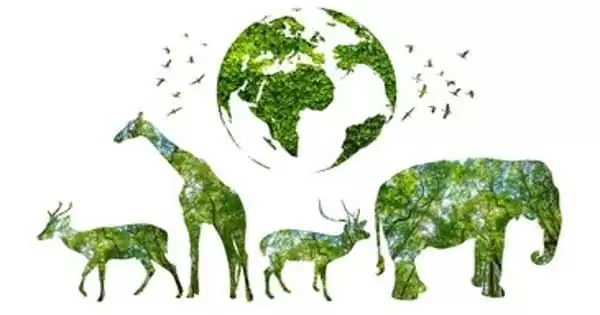In their greed, hunters and traders in fur, ivory, animals, and animal articles have plundered forests and killed millions of innocent animals all over the world, causing many animals to become extinct and threatening many others. These heinous crimes are still being committed. The fact that living creatures are so dependent on each other, and that the survival of the human race is also dependent on them, has caused great concern in the international community since the early twentieth century.
Nature has always been at the heart of human existence. Over time, we, humans, have exploited and ravaged the foundation of our very existence in a variety of ways in the so-called quest for development and inventions, and discoveries.
The physical surroundings and conditions of the environment include the quality of air, water, greenery, vegetation, and all forms of living creatures that form a habitat. Most of us have witnessed the “Web of Life” at some point in our lives, which demonstrates that all forms of life, from algae and fungi to humans, rely on one another for survival. Extinction of any species or creature only serves to disrupt the normalcy of a balanced ecology’s cycle.
The World Conservation Union passed a resolution in 1963 calling for an international convention on regulations governing the export, transit, and import of rare or threatened wildlife species, as well as their skins and trophies. After ten years, 21 countries signed the Convention on International Trade in Endangered Species of Wild Fauna and Flora (CITES). The primary goal is to reduce overexploitation through international trade.
The endangerment of various species as a result of the trade in skins of lizards, monitors, snakes, and other reptiles sold in the millions, as well as tiger horns, bear paws, and gall bladders, prompted India to enact the Wildlife (Protection) Act 1972. By Ratification, India became a member of CITES in 1976.
However, the Wildlife (Protection) Act of 1972 contained flaws and loopholes that were exploited by unscrupulous traders, prompting an amendment in 1986. CITES had a significant impact on the Wildlife (Protection) Act 1972, which resulted in an amendment in 1991 that made the act even more stringent. Some of the salient features of the amendment were: That all hunting of Wildlife under Appendix, I of Cites was prohibited. Collection and Trade in Specified plants (Dead or Alive) were prohibited.
Verification and marking of licensed dealers’ stock of wildlife products with identification were required. Transportation of wildlife and wildlife products necessitated a permit from an authorized officer certifying that the product was legally obtained. Ivory trade and its products were outlawed entirely. It was prohibited to issue a firearms license within 10 kilometers of a sanctuary without the approval of the wildlife warden. Vehicles, Arms, Vessels, and Weapons used to commit Act-related offenses were to be seized. Commercial felling and exploitation of flora have been prohibited. Individuals and non-governmental organizations were permitted to bring violations directly to court. A Central Zoo Authority was set up to ensure sound management of the zoo.
CITES has played a significant role in the development of wildlife in India by collaborating with organizations such as WWF-India and TRAFFIC-India to improve CITES enforcement through policy and law, control trade in wildlife and wildlife products, and organize training courses for enforcement agencies such as police, customs, central forensic labs, INTERPOL officials, parliamentarians, and members of the judiciary, among others. It was discovered that only with the coordination and cooperation of these officials could the CITES objectives be met.
The enforcement of CITES, on the other hand, was the responsibility of member states. Amritsar, Dehradun, Delhi, Guwahati, Kolkata, Mumbai, Chennai, Cochin, and Tuticorin have all established CITES management centers. India is also required to submit an annual report to CITES on its progress.
Some important Points of The Wildlife (Protection) Act 1972 –
(a) Wildlife may include any animal, bees, butterflies, crustacea, fish, and moths; and aquatic or land vegetation that form part of any habitat.
(b) Wild animal would mean any animal found wild in nature and includes any animal specified in Schedule I, Schedule II, Schedule III, Schedule IV or Schedule V wherever found.
(c) Habitat would include land, water, or vegetation which is the natural home of any wild animal.
(d) Hunting is defined as the capture, killing, poisoning, snaring, and trapping of any wild animal, as well as any attempt to do so or even driving an animal for the purpose. Hunting would also include injuring, destroying, or taking any part of the body of such an animal, bird, or reptile, as well as damaging or disturbing their eggs or nests.
(e) The trophy would include the whole or part of any captive wild animal other than vermin preserved by natural or artificial means, as well as rugs, skins, and taxidermy specimens of such animals. Trophy includes antlers, horn hair, feathers, nails, tooth musk, eggs, and the nest.
(f) Specified plants refer to the plants specified under Schedule VI.
Hunting:
Schedules I, II, III, and IV of the Act make it illegal to hunt any wild animal. There are some exceptions, such as when the Chief Wildlife Warden is satisfied that the animal has become dangerous to human life or is diseased or disabled beyond recovery and issues a written order stating the reasons. It is not an offense to kill or wound in self-defense or in good faith. Such an animal, however, shall be the property of the government.
The Chief Wildlife Warden may grant a permit to hunt any wild animal for education, scientific research, and management (reallocation to suitable habitat/population management without killing, poisoning, or destroying wild animals), collection of species for zoos, museums, and similar institutions, and collection and preparation of snake venom for the manufacture of drugs upon payment of prescribed fees. Prior permission will be required in the case of animals listed in Schedule I, which will be granted by the Central Government, and in the case of all other animals, which will be granted by the State Government.
Weapons are also not permitted without prior permission from the Wildlife Warden. The Wildlife Warden is responsible for immunizing livestock within 5 kilometers of the sanctuary against all communicable diseases. By notification, the State Government may also designate an area within or outside of a sanctuary as a National Park due to its ecological, floral, fauna, geomorphologic, natural, or zoological association of importance.
(a) The boundaries may be altered only by a resolution of the State Legislature.
(b) Littering and arson are also prohibited. Grazing of livestock is also prohibited.
(c) The State Govt. may close for hunting any area for such period as may be specified by notification and shall be known as a closed area.
In the case of zoos, there is also a Central Zoo Authority that specifies the minimum standards for animal housing, upkeep, and veterinary care, as well as accessing the functioning of Zoos by maintaining stud-books, coordinating the acquisition, exchange, and loan of animals for breeding purposes, and so on.
Wild animals are essentially the government’s property. If a person has such an animal or article in his possession, he must report it to the nearest police officer within 48 hours or hand it over to the officer-in-charge. No one may acquire, possess, transfer, destroy, or damage such government property. In the case of legal possession, the Chief Wildlife Warden may grant a certificate of ownership, which he may mark in a prescribed form for identification.
Trade or commerce in trophies, animal articles, and other items listed in Schedule I, Part II of Schedule II is illegal. This includes the production and importation of ivory, as well as taxidermy dealing with trophies, captive animals, or their meat. No one other than the person has been issued a certificate to keep, sell, offer to sell, or transfer any of the above-mentioned animals or animal articles.
On reasonable suspicion, the Director or any other officer authorized by him, or any Chief Wildlife Warden, may require inspection of any captive animal, wild animal, meat, trophy (cured/uncured), specified plants, or parts thereof, or licenses or permits. It may also stop any vehicle to search or inquire, as well as enter and search premises, land, vehicles, vessels, open baggage, or other possessions. In the case of illegal possessions, he may seize the illegal possession as well as the tools, traps, vehicles, vessels, or weapons used to commit the crime. It is also possible to be arrested without a warrant.
Officers under the Wildlife (Protection) Act of 1972 are considered public servants, and their actions in good faith are not punishable. Persons who assist in the detection of an offense may be rewarded up to 20% of the fine imposed. Despite the Act’s stringent provisions, its implementation is appalling. Every day, a news story about animal cruelty or the trade in reptiles or big cat skins appears in the news.
Mr. S.K. Niraj, Deputy Director Wildlife, Northern Region, seized 29 python skins (Python reticulates) from a leather factory in Dharavi in a recent case in Mumbai. Three people were detained, including a Dutch woman who claimed she brought the skins from Italy with the knowledge of Customs officials. It is now thought that the skins were obtained from both domestic and foreign sources. This is the fifth or sixth case in a row, with leads coming from as far away as the Netherlands, Italy, Singapore, and Malaysia. In a previous case, six snakeskin handbags believed to have been smuggled from China via Dubai were seized.
A quick search for exotic leathers on the Internet yields thousands of sites and businesses selling and manufacturing products made from reptile skins. Exotic leather is back in style, and it’s wreaking havoc on several endangered species. Many countries allow the manufacture and trade of reptile products such as coats, shoes, bags, and belts. There are several snakeskin manufacturing units in China, Thailand, and Malaysia.
The Wild Life (Protection) Act of India makes all trade in reptile products illegal. However, a shady trade exists. Several seizures of snake skins and other reptile skins have occurred in the last two years. In a major case in Bangalore in July 2002, police arrested one person and seized 35,100 snake skins (mostly rat snake and cobra) and 12 bags containing cut pieces of lizard skins. In the international market, the haul was valued at Rs. one crore (the US $ 2,10,000). The skins were allegedly brought from a village in the Chittoor District of Andhra Pradesh’s southern state. They were being taken to Chennai from where they were to be shipped to Singapore. Other large seizures have taken place in Tamil Nadu, Maharashtra, Andhra Pradesh, and Uttaranchal.
India has a long history of trade in reptiles; four million snake skins (mostly rat snake skins) were legally exported in 1977. It is believed that the trade was so extensive that it played a significant role in the massive increase in the rat population, which decimated food grain stocks, particularly in the 1970s. The export of snakeskin products was finally prohibited in 1986, and despite vigorous appeals from reptile traders and a stay order, the ban was upheld on March 20, 1997. The Indian government publicly burned 1,60,000 snakeskins and over 5,000 reptile skin shoes and bags in New Delhi’s National Zoological Park in 1999. Bharat Leather Corporation, an Indian government enterprise involved in the export of leather goods, had held these stocks for several years. Similar to the trade-in of big cat skins, it appears that the wheel has turned again, endangering the future of our snakes and other reptiles.
Actually, the fascination with the animal’s skin and the large sums of money involved in the trade is the main reasons for such hunting and forest plundering. The Law alone will not be able to completely stop it. It can’t be stopped unless the rich, who are the main consumers of such items, understand the futility of consuming such items unorthodox call sally aspect of killing innocent animals. Awareness is necessary to protect wildlife throughout the world.
















